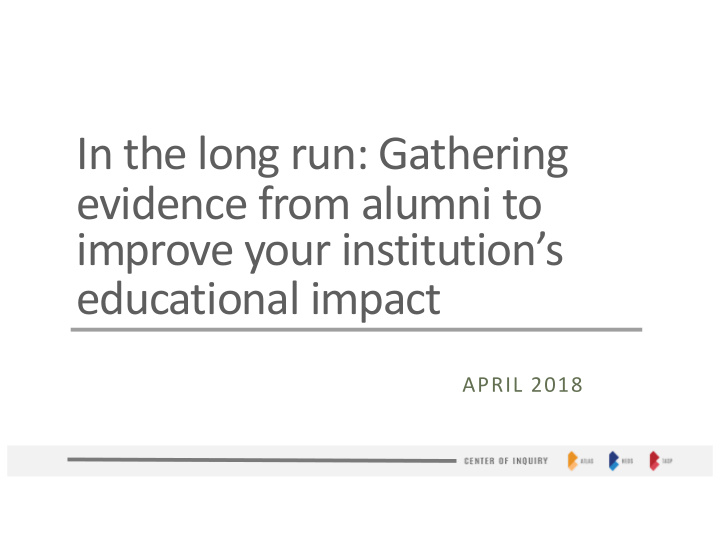



In the long run: Gathering evidence from alumni to improve your institution’s educational impact APRIL 2018
The Center of Inquiry § Work with faculty, staff, administrators, and students to improve learning and teaching at 2- and 4-year colleges and universities § Nonprofit § Consulting § Teagle Assessment Scholar Program § HEDS – Higher Education Data Sharing Consortium � 142 private colleges and universities
Wabash National Study § 49 institutions § 17,000 students § Longitudinal § Purpose � Identify practices and conditions that promote liberal learning � Work with institutions in the study to use evidence for improvement
Wabash National Study Good Practices § Good teaching � Faculty/staff interest in teaching and student development � Out-of-class student/staff & student/faculty interactions � Organization, preparation, clarity, prompt feedback § Academic challenge � Hard work, challenging assignments and interactions § Diversity � Meaningful interactions
Can we use what we learned about good practices in the Wabash Study to understand more about the long-term impact of college?
HEDS Alumni Survey § Overhauled in 2011 to connect Wabash National Study measures of good practices and AAC&U LEAP-influenced learning outcomes § Designed for alumni 5 and 10 years post graduation, but includes other cohorts § Overall – 49,887 alumni and 107 institutions § For today – 19,564 alumni at 59 institutions
HEDS Alumni Survey § Questions on � Demographic information including employment and student debt � Good practices experienced as undergraduates � Impact of undergraduate education on 13 outcomes � Activities in college and the impact of those activities � Satisfaction and connection with undergraduate institution § Survey typically takes about 15 minutes to complete § Response rates are roughly 25%
HEDS Alumni Survey § Good practice questions � Good teaching o Faculty interest in teaching and student development (4 questions) o Quality of non-classroom interactions with faculty (5 questions) � Academic challenge o Challenging classes and high faculty expectations (6 questions) o Higher order exams and assignments (8 questions) � Diversity experiences (6 questions)
HEDS Alumni Survey Intellectual Outcomes § Careful reading § Effective writing § Critical thinking § Effective speaking § Creative thinking § Teamwork § Information literacy § Problem solving § Quantitative literacy § Integrative thinking
HEDS Alumni Survey Civic Outcomes § Civic engagement § Intercultural knowledge and competence § Ethical reasoning § Civic and social involvement
What’s the relationship between good practices and outcomes?
Intellectual Outcomes § Academic challenge ( b = 0.53) § Good teaching ( b = 0.20) § Diversity ( b = 0.06) § R 2 = 0.48 § Controlling for gender, race, and graduation cohort
Civic Outcomes § Diversity ( b = 0. 40) § Academic challenge ( b = 0.26) § Good teaching ( b = 0.15) § R 2 = 0.45 § Controlling for gender, race, and graduation cohort
What’s the relationship between good practices and alumni satisfaction and sense of connection?
Connection § Good teaching ( b = 0.36) § Academic challenge ( b = 0.12) § Diversity ( b = 0.09) § R 2 = 0.24 § Controlling for gender, race, graduation cohort, amount borrowed
Satisfaction § Good teaching ( b = 0.44) § Academic challenge ( b = 0.20) § Diversity ( b = – 0.03) § R 2 = 0.33 § Controlling for gender, race, graduation cohort, amount borrowed
Importance of disaggregating
Diversity by Major § Top Four § Bottom Four � History � Physical Sciences � Philosophy and Religious � Mathematics and Statistics Studies � Business, Management, � Social Sciences Marketing, and Related Support Services � Multi/Interdisciplinary Studies � Engineering
Good Teaching by Gender and Ethnicity 4.35 4.30 4.25 4.20 4.15 4.10 4.05 4.00 Asian American/Asian African American/Black Hispanic/Latino White Women Men
Good Teaching by Gender and Ethnicity 4.35 4.30 4.25 4.20 4.15 4.10 4.05 4.00 Asian American/Asian African American/Black Hispanic/Latino White Women Men
Good Teaching by Gender and Ethnicity 4.35 4.30 4.25 4.20 4.15 4.10 4.05 4.00 Asian American/Asian African American/Black Hispanic/Latino White Women Men
Academic Challenge by Gender and Ethnicity 4.15 4.10 4.05 4.00 3.95 3.90 3.85 3.80 3.75 Asian American/Asian African American/Black Hispanic/Latino White Women Men
Academic Challenge by Gender and Ethnicity 4.15 4.10 4.05 4.00 3.95 3.90 3.85 3.80 3.75 Asian American/Asian African American/Black Hispanic/Latino White Women Men
Academic Challenge by Gender and Ethnicity 4.15 4.10 4.05 4.00 3.95 3.90 3.85 3.80 3.75 Asian American/Asian African American/Black Hispanic/Latino White Women Men
Strengths § Gives you information about good practices and supportive conditions that can be disaggregated by department, program, and background characteristics § Good practices also matter for alumni connection and satisfaction § Marketing material… assuming the results are good
Weaknesses § Strong response bias � You’ll hear from happy graduates § Low response rates � Use multiple ways of collecting data o Web survey o Paper survey at alumni events o Mobile device survey
Types of reporting § Do you know what people want to know about alumni? � If so, your reports should be structured to address those questions � If not, ask § Keep it simple and keep it thematic � Each tab on a spreadsheet answers a question � Graphics that are self explanatory § Ask people what they learned from your reports
Table of Contents 1. Personal Information 2. Post-College Activities 3. Good Teaching 4. Challenge 5. Diversity 6. Civic Engagement 7. College Activities 8. Satisfaction 9. Technical Information Story 1. Who are they 2. What are they doing 3. What did they experience as undergrads 4. What did they do as undergrads 5. How do they feel about their undergrad education now?
Summary § Asking alumni about good practices and supportive conditions provides useful and actionable information § Disaggregate across good practices and outcomes; the stories can be complicated § Assess your reports
Questions?
Recommend
More recommend